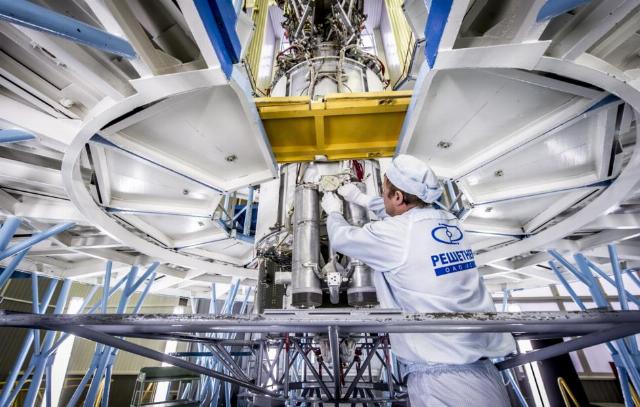June 4 marked the 65th anniversary of the founding of the Academician M.F. Reshetnev Information Satellite Systems enterprise (Reshetnev JSC, part of the Roscosmos State Corporation). Having started its history as a branch of the famous Sergei Korolev OKB-1, which worked on ballistic missiles, the company has become a leading Russian manufacturer of communications and navigation satellites. On the formation of domestic satellite groupings and their future — in the material of TASS
The end of the 1950s was a triumph for the Soviet space industry. The world's first artificial Earth satellite and the Soviet scientific space laboratory Sputnik-3 with a mass of 1.3 tons entered orbit, and the first living creature, the dog Laika, went on an orbital journey. The first automatic interplanetary station Luna-1 flew to the natural satellite of our planet, which for the first time accelerated to the second cosmic speed and became an artificial satellite of the Sun.
However, most of the space programs were military, designed to strengthen the country's defense capability. Since the end of World War II, the world has been on the verge of global conflict, and the Soviet Union needed a nuclear shield with reliable means of delivering atomic charges to targets. Ballistic missiles that could not be intercepted could not be better suited.
In 1958-1959, the founder of Russian cosmonautics, Sergei Korolev, promoted the creation of new scientific and production sites in remote regions from the center — in the Volga region, the Urals, and Siberia. In the event of large-scale hostilities, they would be able to preserve the potential of the rocket and space industry. In addition, enterprises, design bureaus and research institutes would be self-sufficient growth points in regions rich in raw materials.
One of the results of this approach was the appearance in 1959 of the OKB-1, headed by Korolev, of the Siberian branch near Krasnoyarsk (now Zheleznogorsk, Krasnoyarsk Territory). Mikhail Reshetnev, 35-year-old deputy chief designer of rocket and space technology, became its head. Since 1961, the organization has become an independent OKB-10. Subsequently, OKB-10 became known as NPO Applied Mechanics (NPO PM), and later received the name of its first head. The branch began its activity with the design support and production of the R-14 medium-range ballistic missile. In 1962, the first Siberian-built rocket of this type was tested, and in 1964 a light-class carrier rocket of the Kosmos type, built on the basis of the combat R-14, was launched from the Baikonur cosmodrome. By 2010, 773 spacecraft had been launched into orbit using its Kosmos-3M modification.
However, the main specialization of the design bureau was the creation of communication satellites, navigation and geodetic satellites.
Zeroing the distance
Already at the first launches, the Kosmos launch vehicle launched experimental satellites of the Strela low-orbit communication system weighing 50 kg into orbit — a development of OKB-10. Later, they began to be launched in blocks of five spacecraft (spacecraft), then they were replaced by more advanced vehicles of this series.
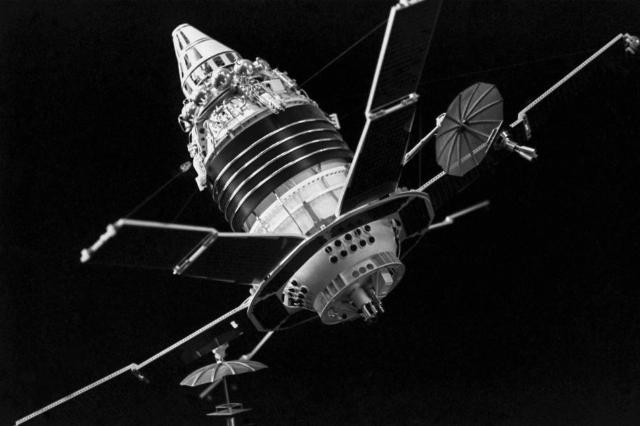
The Molniya-1 spacecraft
Image source: © Albert Pushkarev/ TASS
In the mid-1960s, the company began production of the Molniya-1 series spacecraft, on the basis of which the world's first broadcasting and communication system in high elliptical orbits was created. The first trial session of satellite communication between Moscow and Vladivostok took place in November 1967. Space repeaters weighing 1.6 tons were removed at an apogee of 40 thousand km from the Earth, providing satellite visibility for 8 hours throughout the territory of the Soviet Union. In addition to the TV signal, the "Lightning" allowed the transmission of telephone communication channels.

Orbita Terrestrial television Station
Image source: © Bartholomew Teterin/ TASS
The ground—based receiving stations that transmitted the received signal to end users were named "Orbit" and were equipped with the latest technology - the station's antenna "dish" continuously monitored the passing satellite, and to increase sensitivity, the amplifiers were cooled with liquid nitrogen. Now Central Television broadcasts could be received in the most remote corners of the USSR.
Boris Chertok
"Rockets and people. The Hot days of the Cold War"
In the mid-1970s, the company's satellites began to explore geostationary orbits. A feature of the spacecraft in such an orbit is its constant position relative to the Earth's surface. Consequently, the ground equipment was simplified — there was no need to move the receiving antenna behind the spacecraft. The experimental communications satellite Molniya-1C ("stationary"), Raduga, compatible with the receiving stations Ekran, went into space. In October 1976, the Ekran spacecraft developed by NPO PM, considered the world's first serial satellite for direct television broadcasting, entered a circular orbit with a height of 36 thousand km, close to stationary. It was equipped with a television repeater with an unprecedented power of 300 Watts at that time, which made it possible to receive its signal to simple and inexpensive subscriber devices in Siberia, the Far North and the Far East.
In the late 1970s, the country was preparing to host the Moscow Olympics. The Ministry of Communications ordered the innovative multifunctional telecommunications geostationary satellite Horizon from NPO PM at that time. Several such devices were developed and put into orbit in advance, which ensured that sports competitions were broadcast to the entire planet.
The Celestial Compass
In the late 1950s and early 1960s, work began in the USA and the USSR to create satellite navigation systems. The American Transit system, which helps the United States Navy, was the first to work. In 1967, the first domestic navigation satellite of the future civil navigation system "Cicada" went into space, which was commissioned in 1979. It included four low-orbit spacecraft. The satellite grouping in the interests of the Navy of the USSR was named "Cyclone". The military navigation system became the first in the world to be supplemented by a communication system between Navy ships and coastal control points. Subsequently, the equipment of the COSPAS-SARSAT international space search and rescue system began to be placed on the Cicadas, which helped save thousands of lives. By today's standards, the navigation system was imperfect: the time to determine the coordinates could be several hours, and the accuracy was about 100 m.
On October 12, 1982, the first device of the fundamentally new GLONASS navigation group entered orbit. By 1995, 24 Glonass spacecraft of the first generation of the company's development were already operating in space. However, in the difficult 1990s, due to economic problems in the state, the system began to degrade: satellites failed, but no new ones were launched.
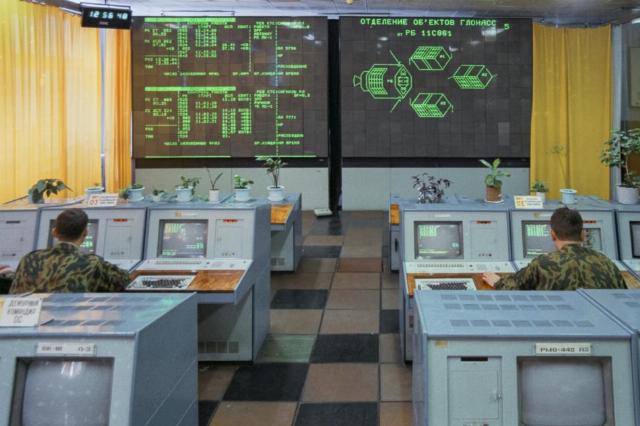
GLONASS Control Room, 1999
Image source: © Mikhail Dyuryagin/ TASS
By the early 2000s, only seven Glonass operational vehicles remained in orbit. The federal target program adopted in 2002 made it possible to reverse the situation. Currently, GLONASS consists of 28 satellites in orbits with a height of about 19 thousand km, of which 24 devices are in operation. The accuracy of determining coordinates using modern satellite navigation systems is about 2 cm.
In the "Sphere" of special attention
Today, it can be considered the Russian leader in the field of telecommunications satellites. The priority area of the company's work is the development and production of devices for the Sphere multi—satellite constellation, the deployment program of which was announced by Russian President Vladimir Putin in the summer of 2018. It is assumed that the "Sphere" will include about 600 spacecraft, which will make up five communication groups and five observation groups.
In 2022, the CEO of Academician M.F. Reshetnev Information Satellite Systems JSC said in an interview with TASS that within the framework of the Sphere, engineers are developing spacecraft groupings responsible for communications. This is the Skif communication system, which will consist of 12 spacecraft. The group will provide the entire territory of Russia with broadband Internet.
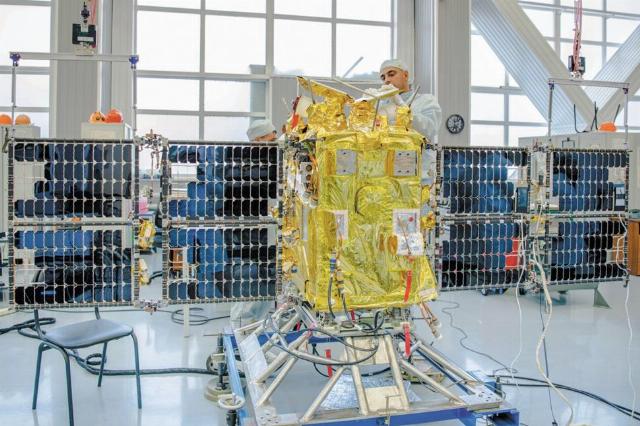
The Skif-D satellite
Image source: © The Official Telegram Channel of the Roscosmos State Corporation
The first satellite, Skif-D, which became a technology demonstrator and a pioneer of the Sphere, was launched into orbit on October 22, 2022. In May of this year, Reshetnev JSC received a contract for the manufacture of four Scythians in the final version. The devices weighing 1,750 kg are designed for 12 years of active operation.
In September 2023, Reshetnev JSC signed a contract with Roscosmos State Corporation for the production of 132 devices of the Marathon-IoT data transmission system for the Internet of Things — part of the Sphere project. According to Yevgeny Nesterov, the grouping will include 264 Marathon spacecraft weighing 50 kg each. The launch of the first spacecraft is expected this year. To ensure mass production, satellites must be made in the form of monoblocks with built-in equipment. On the basis of the Marathon platform, it is planned to deploy a streaming release of satellites of this class with various purposes.
Yuri Borisov, Director General of Roscosmos, in an interview with Rossiya-24 TV channel noted that the transition to serial production of spacecraft requires unification and standardization of technical solutions, reduction of the nomenclature of the element base.
Yuri Borisov
CEO of Roscosmos State Corporation
Three more groups of "Spheres", satellites for which the company's specialists are developing, are the Yamal, Express and Express-RV communication systems. The technical design of the latter has already been completed. Express-RV will include four satellites in highly elliptical orbits. It is planned that they will provide broadband Internet access throughout the Russian Federation and the Arctic Ocean, and the first device will be launched in the fall of 2025.
Navigation, communication and artificial intelligence
The development of the multifunctional low-orbit personal satellite communication system Gonets-D1M from 12 devices continues. It can be used both for communication, data transmission, and for determining the location of mobile objects, scientific and environmental monitoring. Reshetnev JSC plans to produce satellites for this communication system with a clock cycle of seven days.
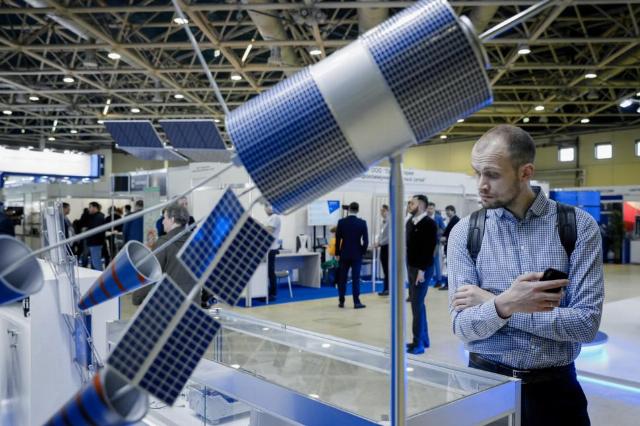
Multifunctional personal satellite communication system "Gonets-D1M"
Image source: © Gavriil Grigorov/ TASS
Satellites of the GLONASS navigation system are being developed — it is planned to update it with new generation navigation satellites Glonass-K2. In early 2022, the company announced the conclusion of a contract with Roscosmos for the manufacture of 11 spacecraft of this type.
Reshetnev JSC is developing the first fully domestic spacecraft consisting entirely of Russian components, the Express-AMU4 communications satellite. It is planned to start assembling the device in the autumn of this year, and finish the work in 2026.
Satellite production technologies are also being improved. Thus, the company's specialists are preparing large technological databases for the purpose of programming artificial intelligence. It will be used to calculate the operating modes of metal-cutting machines during the machining of spacecraft parts.
Victor Bodrov
